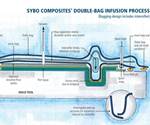Absolute vacuum gauge
The following is an excerpt from Issue 12 of The Composites Letter, published by www.vacmobiles.com (reposted here by permission) that outlines the importance of using an absolute vacuum gauge to measure pressure levels during double-bad infusion:“Often called a precision vacuum gauge, an absolute gauge actually works the opposite way to a conventional dial type vacuum gauge.
The following is an excerpt from Issue 12 of The Composites Letter, published by www.vacmobiles.com (reposted here by permission) that outlines the importance of using an absolute vacuum gauge to measure pressure levels during double-bad infusion:
“Often called a precision vacuum gauge, an absolute gauge actually works the opposite way to a conventional dial type vacuum gauge. The latter measures the pressure differential below the atmospheric pressure surrounding the gauge. An absolute pressure gauge measures the actual pressure above the absolute zero of pressure. Using the absolute zero of pressure as a reference provides far more accurate measurements of vacuum levels for high-quality infusion and prepreg laminating, because it is a fixed point of reference uninfluenced by environmental factors. The atmospheric pressure reference point used by dial type vacuum gauges varies widely with changes in weather and geography. A good quality oil lubricated vacuum pump suitable for high quality vacuum infusion or prepreg work will achieve an absolute pressure of 10 mbar to 20 mbar above the absolute zero of pressure at the pump. It is not uncommon for this type of pump to achieve absolute pressures in the vacuum bag in the 20mbar to 30mbar range. In order to confirm that a bag has been evacuated to this degree of vacuum, the gauge used needs to be accurate in this region. This is practically impossible for conventional dial type gauges, which will experience inaccuracies of at least ±25 mbar from weather variations alone, plus those due to the mechanism within the gauge, typically between 1 and 3 percent of full scale, adding perhaps another ±30 mbar of error. Thus, a vacuum gauge with a total accuracy of ±55 mbar is not appropriate for measuring an in-bag vacuum of 10 to 30 mbar.”
Related Content
-
Ceramic matrix composites: Faster, cheaper, higher temperature
New players proliferate, increasing CMC materials and manufacturing capacity, novel processes and automation to meet demand for higher part volumes and performance.
-
From the CW Archives: Airbus A400M cargo door
The inaugural CW From the Archives revisits Sara Black’s 2007 story on out-of-autoclave infusion used to fabricate the massive composite upper cargo door for the Airbus A400M military airlifter.
-
Melker of Sweden accomplishes sea kayak with 100% sustainable composite construction
Built with ampliTex flax fabrics, a solid cork core and Sicomin plant-based resins, the company’s Värmdö kayak model highlights an environmentally conscious design for paddlers of all levels.


